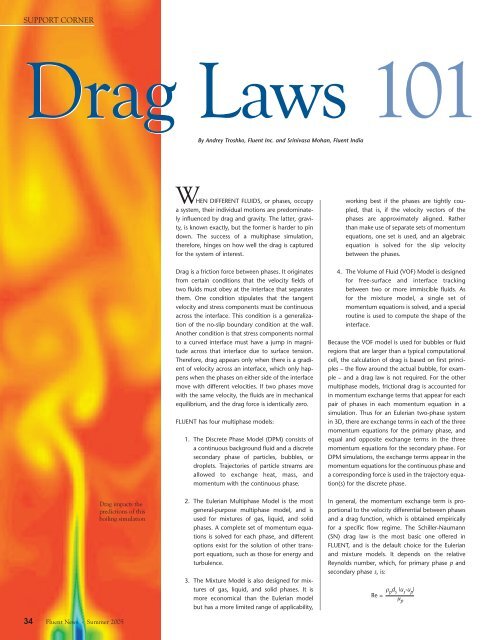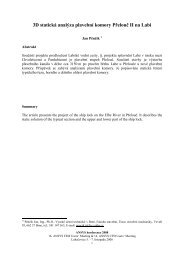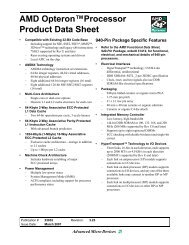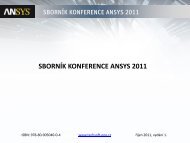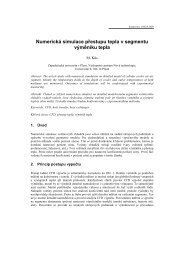Fluent Newsletter Summer 2005
Fluent Newsletter Summer 2005
Fluent Newsletter Summer 2005
Create successful ePaper yourself
Turn your PDF publications into a flip-book with our unique Google optimized e-Paper software.
SUPPORT CORNERDrag Laws 101By Andrey Troshko, <strong>Fluent</strong> Inc. and Srinivasa Mohan, <strong>Fluent</strong> IndiaWHEN DIFFERENT FLUIDS, or phases, occupya system, their individual motions are predominatelyinfluenced by drag and gravity. The latter, gravity,is known exactly, but the former is harder to pindown. The success of a multiphase simulation,therefore, hinges on how well the drag is capturedfor the system of interest.working best if the phases are tightly coupled,that is, if the velocity vectors of thephases are approximately aligned. Ratherthan make use of separate sets of momentumequations, one set is used, and an algebraicequation is solved for the slip velocitybetween the phases.Drag is a friction force between phases. It originatesfrom certain conditions that the velocity fields oftwo fluids must obey at the interface that separatesthem. One condition stipulates that the tangentvelocity and stress components must be continuousacross the interface. This condition is a generalizationof the no-slip boundary condition at the wall.Another condition is that stress components normalto a curved interface must have a jump in magnitudeacross that interface due to surface tension.Therefore, drag appears only when there is a gradientof velocity across an interface, which only happenswhen the phases on either side of the interfacemove with different velocities. If two phases movewith the same velocity, the fluids are in mechanicalequilibrium, and the drag force is identically zero.FLUENT has four multiphase models:1. The Discrete Phase Model (DPM) consists ofa continuous background fluid and a discretesecondary phase of particles, bubbles, ordroplets. Trajectories of particle streams areallowed to exchange heat, mass, andmomentum with the continuous phase.4. The Volume of Fluid (VOF) Model is designedfor free-surface and interface trackingbetween two or more immiscible fluids. Asfor the mixture model, a single set ofmomentum equations is solved, and a specialroutine is used to compute the shape of theinterface.Because the VOF model is used for bubbles or fluidregions that are larger than a typical computationalcell, the calculation of drag is based on first principles– the flow around the actual bubble, for example– and a drag law is not required. For the othermultiphase models, frictional drag is accounted forin momentum exchange terms that appear for eachpair of phases in each momentum equation in asimulation. Thus for an Eulerian two-phase systemin 3D, there are exchange terms in each of the threemomentum equations for the primary phase, andequal and opposite exchange terms in the threemomentum equations for the secondary phase. ForDPM simulations, the exchange terms appear in themomentum equations for the continuous phase anda corresponding force is used in the trajectory equation(s)for the discrete phase.Drag impacts thepredictions of thisboiling simulation34 <strong>Fluent</strong> News · <strong>Summer</strong> <strong>2005</strong>2. The Eulerian Multiphase Model is the mostgeneral-purpose multiphase model, and isused for mixtures of gas, liquid, and solidphases. A complete set of momentum equationsis solved for each phase, and differentoptions exist for the solution of other transportequations, such as those for energy andturbulence.3. The Mixture Model is also designed for mixturesof gas, liquid, and solid phases. It ismore economical than the Eulerian modelbut has a more limited range of applicability,In general, the momentum exchange term is proportionalto the velocity differential between phasesand a drag function, which is obtained empiricallyfor a specific flow regime. The Schiller-Naumann(SN) drag law is the most basic one offered inFLUENT, and is the default choice for the Eulerianand mixture models. It depends on the relativeReynolds number, which, for primary phase p andsecondary phase s, is:Re =ρ p d s |u s -u p |µ p


